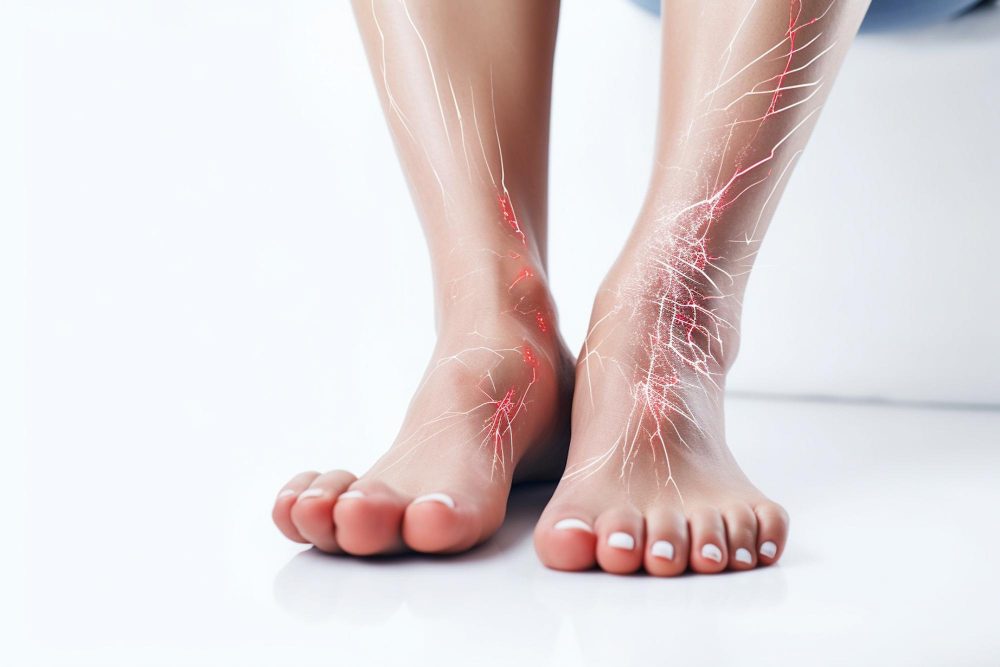Diabetic Foot

Diabetic Foot is a condition characterized by foot complications resulting from diabetes. What are the measures to mitigate it? Here are five useful recommendations.
Diabetes. Ordinary tasks now demand more caution and mindfulness.
Take your feet, for instance. They are far more vulnerable to injuries than feet that are considered “normal”. Furthermore, injuries have impaired healing capacity as a result of compromised blood circulation. In the worst scenario, it leads to the development of a diabetic foot.
What is the cause of that occurrence?
Diabetes frequently results in neuropathy, which is the destruction to the peripheral nerve terminals in the foot. This is frequently accompanied by a sensation of numbness, which results in delayed awareness of the wounds. A minor injury will quickly have the opportunity to become inflamed.
Maintain optimal foot health. Perform a thorough examination of your feet each night prior to retiring for the evening and make routine appointments with a podiatrist. That can effectively mitigate a significant amount of suffering.
- Your dietary regimen
Consume food and beverages at regular intervals and with deliberate awareness.
Stay hydrated by consuming ample amounts of water. Approximately 1.5 to 2 liters every day. The kidneys are functioning sub-optimally, resulting in a decrease in the body’s water content.
Consume meals at regular intervals, ensuring they are nutritious and portioned evenly, preferably in smaller sizes. Fluctuating blood glucose levels have the potential to cause harm to nerves and blood vessels. The appropriate medical terminology for this condition is Peripheral Neuropathy. Peripheral neuropathy is a distressing ailment that can occasionally lead to diminished sensation in the feet. The symptoms encompass pruritus (itching) and disruption of the vestibular system.
2.Engage in daily physical activity.
Engaging in physical activity enhances blood circulation and reduces blood pressure. Select a sport that heavily involves the use of the feet, such as running, cycling, or Nordic walking.
Strive to maintain a consistent level of effort while maximizing movement. Similar to regular eating, this practice helps to stabilize sugar levels and reduce fluctuations.
When selecting sports shoes, ensure that they possess a sturdy and supporting structure, have ample width to accommodate the toes and have a heel that is simultaneously cushioned and firm.
Naturally, the inside lining must have ventilation in order to maintain dryness in your feet.
- Footwear and insoles designed specifically for orthopedic purposes.
Naturally, you have a preference for strolling in stylish and trendy footwear. Regrettably, these particular shoes frequently lack the necessary support for individuals with diabetes. Therefore, it is advisable to select footwear or socks that have been specifically customized and tailored by a podiatrist.
However, this does not imply that you are permanently prohibited from wearing conventional footwear. Modify it. This helps to prevent excessive loading of specific areas in your foot.
Orthopedic shoes or inserts primarily function by evenly distributing body weight across the entire foot and alleviating excess weight. The primary function is typically located in the “arch-support” area. This refers to the support supplied within the hollow space of the foot.
Ensure the safety of your feet. Additionally, it is also suitable for indoor use.
Minimize walking barefoot as much as possible. Regardless of your level of enjoyment. Mere contact of your toes with a table foot can result in a wound that is in the process of healing.
Seek a suitable equilibrium. It is important to maintain an optimal temperature for your feet, avoiding both excessive heat and extreme cold. Elevated temperatures promote bacterial proliferation, while low temperatures hinder blood flow in the foot.
A significant number of individuals have an aversion to wearing their footwear and prefer not to engage in walking activities while wearing them. Purchase orthopedic slippers or place insoles into your sneakers. The footwear must feature a closed heel, else there may be a slight risk of slippage.
- Socks designed specifically for individuals with diabetes.
Do you want a minimalistic sensation under your feet when you are indoors? Consider using diabetic socks as an alternative. These items offer pressure alleviation through gentle compression. The likelihood of experiencing irritation is negligible.
Do you like regular socks? It is within your capability. Despite common assumptions, socks made of 100% cotton have limited moisturizing properties. Cotton has the ability to absorb moisture. Therefore, it provides an optimal habitat for bacteria. Moisturizers made entirely of synthetic material or a blend of cotton are highly effective in keeping your feet drier compared to socks made solely of cotton.
Footlogics offers orthotic insoles that are specifically created and well-suited for individuals with diabetes, arthritis or very sensitive feet.
